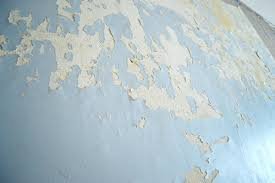Troubleshooting Paint Problems
Preparation of Set Plaster
 Before painting, especially where solvent-borne paints or other relatively impermeable coatings are to be applied, it is advisable to test the plaster with a moisture meter to ensure that the moisture content at the surface does not exceed the acceptable limits for painting. Latex systems are more tolerant of moisture; however, high concentrations of moisture may cause salt transfer (efflorescence) and blistering.
Before painting, especially where solvent-borne paints or other relatively impermeable coatings are to be applied, it is advisable to test the plaster with a moisture meter to ensure that the moisture content at the surface does not exceed the acceptable limits for painting. Latex systems are more tolerant of moisture; however, high concentrations of moisture may cause salt transfer (efflorescence) and blistering.
Moisture ingress into previously painted plaster may be detectable without the use of a moisture meter, through effects such as blistering of the coating, efflorescence below or on top of the coating, mould growth on the coating or the plaster, and softness or disintegration of the plaster. General practice suggests that the elevated moisture content should be below 15%.
Premature painting of plaster may cause major and extended problems. If paint is applied to new set plaster that has not had sufficient time to reach a stable equilibrium with regard to hardening, moisture, alkalinity and efflorescence, there will be a lack of hardening and the residual moisture and alkalinity will affect the integrity and adhesion of the coating through blistering, efflorescence and other defects. In addition, the presence of any coating will reduce the rate of moisture loss from the plaster and the rate of ingress of carbon dioxide into the plaster, thus lengthening the time required to achieve equilibrium and full curing. In the event of incompletely cured plaster causing some form of paint failure, rectification will generally require the plaster to be allowed to cure fully, which may in turn require the coating system to be removed. Removal may damage the plaster surface, requiring its reinstatement, thus setting the time of curing back to zero. Painters should resist any form of pressure to paint plaster prematurely, unless a statement of release is obtained, which transfers consequential risks to the party applying such pressure.
RECOMMENDED MINIMUM DRYING TIMES FOR CEMENTITIOUS SURFACES BEFORE PAINTING
Paint type Drying times (weeks)
Latex 4
Solvent-borne acrylic 4
Oleoresinous and alkyd 12
CPCCPD3021 Prepare existing coated surface for painting Learning Resources
For a complete set of industry validated training and assessment resources for CPCCPD3021, including learner guides, assessment tools, RPL Tools and trainer guides, please contact the National Painting and Decorating Institute




